RABBITS AS PETS
Many rabbits are acquired as a child's pet. Unfortunately
many people are surprised and disappointed to find that
rabbits rarely conform to the cute-and-cuddly stereotype
in children's stories. They tend to be too busy dashing
about to be cuddled. It should be remembered that rabbits
are physically delicate animals and can be hurt by being
picked up without supporting them adequately. If this
happens and the rabbit feels frightened, it will kick
and struggle, which means children, can also get hurt.
Rabbits are also built to react to sudden changes, which
means they may either run away or try to bite when approached
too quickly and too loudly. Stressrelated illnesses are
common. For these reasons, many children, especially younger
ones find the initial enthusiasm soon wears off and they
lose interest
If your child is generally easygoing, calm and co-operative,
he or she may get on quite happily with a well-handled
rabbit. On the other hand, if your child is generally
on the loud side and tends to be very active or frequently
seems to need reminders, they may find it difficult to
build a relationship with a rabbit and you may find that
a rabbit is simply an additional stress to all of you.
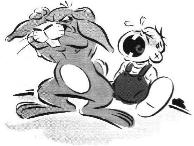
Using pets to teach responsibility
Many parents say they want to get a rabbit to teach their
children to be responsible. What usually happens is that
the child loses interest and the rabbit suffers, The child
may feel bad and resent the animal for the nagging they
get from an adult Often the rabbit is given away because
"you didn't take care of it". The child has
now learnt that life is disposable and that if they wait
long enough, someone else will relieve them of the responsibility.
Let your children help with the rabbit, but don't insist.
Small children particularly enjoy the fact that caring
for a pet is something that children and parents can do
together. The more interest you show and the more you
help out, the more enthusiastic they are likely to be.
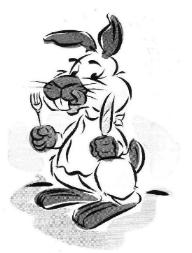
So, if the children appear interested, encourage them.
But, if they become bored, let them move on to the next
thing, and you carry on with the rabbit. They will learn
most from watching your actions and tone of voice when
you speak to the rabbit. From this they will learn about
waiting patiently, caring, and enjoying a living creature
for what it is and not what you want it to be. It is not
easy to manage children and animals. But when parents
find solutions, rather than dispose of an animal for convenience
sake. An important concept is communicated to the child.
Either way, reconcile yourself to the fact that a rabbit
is an adult's responsibility. Rabbits are very sensitive
to changes to their feeding, cleaning, and exercise routines.
Changes are stressful and may lead to illness. Symptoms
of illness are often subtle changes in appetite, behaviour,
or droppings that even older children may miss. It is
unreasonable to expect a child of any age to take sole
responsibility for the care of any pet. The rabbit
and your children, as well as the family peace will benefit
greatly from you accepting this.

Rabbits as companion animals
But rabbits do make good pets. With the active support
of an interested parent, rabbits can make an ideal pet
for an older child. Adults should also consider rabbits
as a pet for themselves. Compared with other domestic
pets, they have a lot going for them:
· Rabbits are quiet and can learn to use a litter
tray just a quickly as a cat.
· They are fun to watch and soon show their personalities
to be just as individual as any dog or cat.
· Rabbits don't necessarily need outdoor accommodation
and will happily live indoors as long as they are given
plenty of space for exercise and access to sunlight.
· Rabbits are social animals and benefit from the
companionship of humans or other animals. Although the
need may vary from rabbit to rabbit. Many enjoy being
with people but your family must have patience, understanding
and an acceptance of individual differences to earn their
trust.
· Rabbits play, some more than others. Many can
get along with most other dogs and cats as long as they
are properly introduced, preferably early in life.

Rabbits as part of the family
Rabbits can be kept in outdoor hutches and allowed to
exercise in the garden as well as in the house.
Alternatively, rabbits can be raised to live exclusively
as house pets. This will require time and patience from
you during the early days as the rabbit becomes house
trained and is taught what not to chew, (this is perhaps
the difficult bit!). More and more people are keeping
"house rabbits" and a well trained and handled
rabbit is a much more entertaining companionable pet than
one confined to the bottom of the garden. A well-managed
house rabbit also enjoys a better quality of life.
Unless you are enthusiastic, informed, and committed
about what is involved a stuffed toy is a better choice!
Keeping a house rabbit
Before you set your heart on having a rabbit around the
house, ask yourself if you really want another "toddler"?
Rabbits are a lot like 2-year-old children. They can be
great fun to live with, but you will need to spend time
in toilet training and must be prepared to tolerate accidents.
You will need to "bunny proof" those parts of
your house where the rabbit is allowed to run in exactly
the
Same way as "toddler proofing". You will need
to check on your rabbit often and supervise play with
children when the rabbit is out for exercise. You also
need to accept that inevitably, some of your precious
possessions may be partially ruined.
Just like toddlers, rabbits benefit from a routine for
feeding, playing and resting. The main thing is to get
into a routine that is easy for you or you may begin to
look at the rabbit as simply one more mess-maker.

Choosing your Rabbit
There are more than sixty-five different breeds of rabbit
ranging in weight from 1kg to 10kg. Some have short, velvety
fur, (Rex), whilst others have long woolly fur, (Angora,
Cashmere), which will require a lot of grooming. Some
have patterned coats with patches, spots or stripes, (Dutch
and English Spot), and there are rabbits with upright,
or floppy ears (the Lop breeds). With so much choice,
it should be easy to find a breed you like.
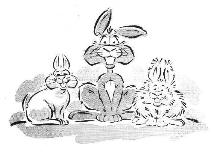
If you are not too bothered about a particular breed check
your local newspaper and the postcards in your local newsagents
or veterinary practice as somebody may have a litter to
sell or give away. Rabbits are sold in pet shops and your
local animal rehoming shelter may have litters to find
homes for. If you really want a specific breed though,
you will have to find a breeder. You should get in contact
with your local rabbit club or go to a local rabbit show,
where there are frequently pedigree rabbits for sale.
Before buying, think how big the rabbit is going to grow
or if it needs extra care. Smaller rabbits, such as the
dwarf breeds, tend to be lively and energetic, while the
larger, giant breeds are usually less active and easier
going. However, they will need a larger cage or hutch.
The long coats of Angoras and Cashmeres tangle easily
and will need grooming every day.
When you go to choose your rabbit, don't be bowled over
by the first fluffy bunny you see. For younger children,
the larger, more placid breeds which they can't pick up,
drop or frighten may be more suitable companions. These
larger rabbits usually bond better with people and are
quite happy to sit alongside you to be stroked.
A rabbit, which is in good condition when you acquire
it, is less likely to present health problems and vet's
bills later on. Ask to hold the rabbit and check that
its coat is sleek and glossy and its eyes are bright and
has no signs of any discharge. There should be no visible
wounds or abscesses on the body and the back should be
firm, without protruding spine. Beware of a rabbit with
a runny nose and check for any signs of diarrhoea or discoloured
fur around the tail. If you are in any doubt, find another
litter to choose your rabbit from.
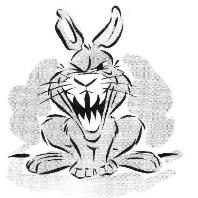
SAFE HANDLING AND RESTRAINT
The safest way to approach a rabbit is to begin by stroking
the top of the head. Most rabbits resist having the tips
of their noses or chins touched. An unacceptable number
of rabbits are injured each year through inappropriate
handling. A frightened poorly secured animal will be at
great risk of a potentially fatal injury to itself such
as a spinal fracture. The handler can also receive painful
scratches if the rabbit is allowed to kick. Rabbits should
generally be picked up with a firm grip over the loose
skin around the neck, always paying attention to support
the rear limbs. This way the rabbit will feel secure and
will not resent handling or examination.
"Trancing"
It is often said that a rabbit can be "hypnotised"
or "tranced" by laying it on its back across
your lap? Holding the rear limbs and tipping the head
backward until it's "out." Initially the rabbit
may struggle but will soon relax with perhaps only the
hind legs quivering occasionally. The rabbit will come
out of this "trance" as quickly as it went into
it? Trying to get itself upright and get away. If you
continue restraining the rabbit, it will simply struggle
and may become aggressive.
Don't think that your rabbit is in a state of total bliss.
When a prey animal such as a rabbit is seized it will
freeze. By becoming immobile and trying to mimic successfully
killed prey, the rabbit increases its chances of escaping
and is less likely to be seriously injured. Thinking it
has killed its prey, the predator may relax its grip,
which stimulates the rabbit to spring into life and attempt
to escape. If the escape is thwarted. the rabbit is likely
to fight in a last ditch attempt to escape death.
This is what your rabbit is doing during "trancing"
That doesn't mean you shouldn't do it. It is extremely
useful when cleaning the rabbit's sensitive areas, like
the face, feet, or under the tail. If the hind feet seem
to be vibrating touching them will usually stop it. This
technique is well worth learning as it is the most convenient
way to inspect a rabbit's front teeth.
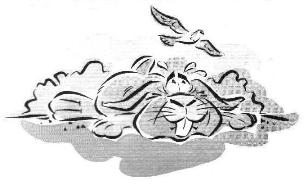
Outdoor accommodation
Most hutches are simply too small for a rabbit to live
in permanently and still maintain good health. Rabbits
need to be able to stretch to their full length and height,
not to mention running and jumping. In a small hutch,
which precludes exercise, they are likely to become bored,
depressed and overweight. If they become overweight, they
will be less able to groom themselves and in the heat
of a small hutch, the likelihood of fly-strike increases.
Provide the biggest hutch and run you can.
Size matters
Imagine living in a cage 2 or 3 times your own size, where
you can barely stretch - let alone exercise - and you
are unable to stand. Shocked? Yet this is the life for
most of the 2 million pet bunnies in the UK, confined
to a hutch measuring on average just 3ft X 1ft X 1ft "Rabbits
are the most abused pets" says Carolina James, Director
of The Rabbit Charity. "People wouldn't dream of
keeping a cat or a dog in the same way." Even hamsters
and other small animals are housed in big cages (compared
to their body size), with room to play and exercise. Most
rabbit hutches are so small, there isn't even room for
toys or a companion. Because rabbits cannot bark or meow,
they suffer in silence and caregivers may not realise
how unhappy and frustrated they are.
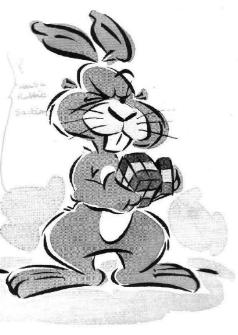
Rabbit habitats
Rabbits are intelligent, social animals who enjoy playing
and exploring, and need to live in pairs. The minimum
recommended cage size for two dwarf lops (the most popular
breed) is 6ft X 2ft X 2ft, but bigger is better. Rabbits
also love double-decker cages where they can hop up and
down and get a look-out. Like other pets, they need to
exercise several hours a day in a BIG outdoor run (daytime
only and with supervision) or in the home. Rabbits don't
have to live in cages and many caregivers now give them
free run of one or more rooms or a secure shed, garage
or conservatory. For more information on keeping bunnies
indoors and outdoors please send an SAE to The Rabbit
Charity, P0 Box 23698 London N8 OWS, e-mail: lnfo@bunny.org.uk,
website: http://www.bunny.org.uk.
There are no hard and fast rules as to what a hutch and
run should look like. All that is required is a dry and
draught free area for sleeping, a sheltered area to keep
food dry - and as much exercise and play area as you can
provide. If you can't find the space, construct a two
or three story apartment with well-secured ramps. Bunny
will love it.
Think where you locate the hutch as well. Light is good
for rabbits as it helps them to develop strong bones,
but leaving your rabbit's hutch against a south-facing
wall in the heat of summer is not a good idea. Bunny will
cook It is far better to place the hutch and run in a
position where the rabbit gets the sun in the morning
or evening, but is provided with shade during the middle
of the day. You should also avoid draughty places on the
side of the house, which gets the worst of the wind. If
the weather becomes really bad, your outdoor rabbit will
be entirely happy in its sleeping area as long as you
provide some extra insulation by throwing and securing
an old piece of carpet or blanket over the hutch.
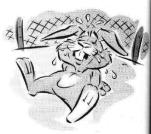
To prevent escape by burrowing out or intrusion from potential
predators digging in, a run should have a top and bottom
as well as sides. One solution is to use wire for the
base, although this can be hard on a rabbit's feet. Another
solution is to place the run on paving slabs.
Outdoor hazards
Even a sturdy hutch does not necessarily protect a rabbit
from predators, such as dogs, cats or foxes. Determined
predators can bend or break wire. Agile ones can open
cage doors. The mere presence of a predator may trigger
an extreme reaction in a rabbit; a panic attack during
which the rabbit runs wildly back and forth, twisting
and thrashing about. A rabbit in this state can break
its own back, or die from a heart attack.
A survivor may be permanently disabled, or develop infection
from bite or claw wounds. It is essential that the wire
is strong with no weaknesses and that the door to the
hutch has a secure fastening. Your rabbit's sleeping quarters
should be well off the ground to ensure it is totally
out of sight of any potential predator. Placing large
diameter clay or plastic drainage pipes in a rabbit's
run also provides as substitute burrow and gives the rabbit
somewhere to play and hide. Finally, an insidious danger
to a rabbit, which is kept permanently out of doors is
inattention from its caretaker Even though the rabbit
is fed, watered, and sheltered, infrequent observation
and handling may mean that health problems to go unnoticed
until too late.

Playtime outside
Many people believe that a rabbit allowed to browse a
garden will instinctively avoid poisonous plants. This
is not always the case and if you intend to allow your
rabbit to wander freely around in flowerbeds, it is advisable
to make a list of all your plants and check for poisonous
ones. Until all poisonous ones are removed, the rabbit
should be confined to its run or kept indoors.
Always supervise your rabbit when it is running around
outdoors. It takes just a few seconds for the neighbour's
dog or cat to jump the fence and attack or frighten your
rabbit to death. Before you allow your rabbit on the lawn,
check that the grass has not been sprayed with pesticides
or fertilisers. Walk the perimeter of your garden and
check thoroughly for holes in the fence. Under no circumstances
should rabbits he left outside after dark. Most of its
predators hunt at night, so it should be secured in its
hutch well before dusk. You should also remember that
wild rabbits may be attracted to the run and they may
be carrying myxomatosis. Touching noses through the wire
may be all that is needed to transmit this killer by the
transfer of fleas.
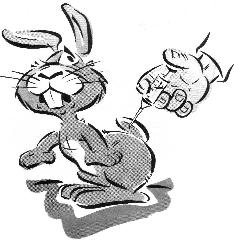
Traditionally rabbits were kept outside all the time but
as people have recognised that they make ideal companion
animals, more and more are being allowed into the house
and many now live inside permanently. As long as they
have exercise, access to sunlight and an appropriate diet,
they will be completely at home! Above we have described
what is required for both outdoor and indoor living. It's
your choice as to which lifestyle you decide upon for
your rabbit.
Rabbits are territorial even when they are living in your
home and for indoor living, your rabbit will need as large
a cage as possible. The type which exhibitors use at dog
shows is ideal and good pet stores will usually have a
selection to choose from. Many have internal plastic trays,
which not only protect your floors, but are also kind
on the rabbit's feet. There is nothing worse than a rabbit
spending all of its time on its litter tray to avoid wire
floors. Alternatively, line the cage with cardboard, but
don't be surprised if your rabbit destroys it every so
often.

A house rabbit often finds its cage a safe haven, returning
there to eat or rest. For psychological security a cardboard
box lined with straw or a synthetic fleece may be added
to the cage. Make the cage enjoyable and they will enjoy
being there, even when the door is open. Keep it stocked
with toys and things to chew any rabbit, even a seemingly
well behaved one, should probably be kept in a cage while
your not home to supervise and at night when you sleep.
When you put it to bed at night give it a vegetable or
fruit snack.
Bunny-proofing
The more an indoor, toilet-trained rabbit is allowed to
mingle with its human family and other pets, the more
it will express its personality and be enjoyed for it.
But, if you are going to allow your rabbit to run in your
home even for short periods, it is essential that you
bunny-proof the environment. This is essential to prevent
damage to your property and to protect your rabbit from
injuring itself.
Some houseplants are poisonous. Putting them on high furniture
may not keep a rabbit away. Hang them from the ceiling
if you have a particularly active bunny, but watch
for falling leaves! If you are unsure, consult a good
reference book.
If a rabbit insists on chewing skirting boards, legs of
chairs and the edges of carpets, condition them to stop
immediately provide them with an alternative
Such as a piece of root vegetable or edible wood. A slap
on the floor next to a misbehaving rabbit and a firm "No"
will get the message over; "thumping" being
a sign rabbits instinctively recognise. A quick shot from
a water pistol whilst it's engaged in the unacceptable
behaviour can help. In addition, most pet shops sell pet
repellents such as bitter apple, which can be sprayed
on objects to deter your rabbit.
Protecting your Rabbit from Harm
Rabbits have an instinct to quickly and casually sever
any cable they encounter. Special temptations are those
which run across the rabbit's path, or through a burrow-like
area, such as behind a settee. "Bunny proofing,"
means encasing electric cables in heavyduty plastic tubing
and blocking the runs behind furniture so the rabbit cannot
use them. It is the single most important step in preparing
an indoor area for a rabbit since they can be badly burned
or electrocuted. The consequences of biting into an electric
wire are too severe to risk relying on training alone.
A rabbit's tendency to chew is often more inconvenient
than hazardous. To prevent your rabbit chewing on your
things, provide natural alternatives such as wood, cardboard,
untreated straw mats, cardboard boxes, the inside of toilet
rolls etc.
Toys
Toys are important, They provide:
Mental stimulation
Without challenging activities to occupy your rabbit when
you're not home, it will get bored. This could lead to
it becoming depressed or destructive. Providing toys will
keep your rabbit interested in its surroundings, particularly
if it is a solitary rabbit.
Physical exercise
Your rabbit needs safe activities to keep it in good physical
shape and to prevent it from becoming overweight. It needs
things to climb on, crawl under, hop on and around, dig
into, and chew on. Without outlets for these physical
needs, besides gaining weight, your rabbit may create
its own diversions with your furniture and carpets.
Suitable bunny toys
Paper bags and cardboard boxes for crawling inside, scratching,
and chewing. Bunnies like them much more when there are
at least two entry points into the boxes
Cardboard rolls from paper towels or toilet paper
Untreated wicker baskets or boxes full of shredded paper,
junk mail minus the wrapping, magazines with the
staples removed, straw, or other organic materials for
digging in.
Pieces of edible wood such as apple, pear, willow or hazel.
Telephone directories for shredding.
Carrots or pieces of root vegetable suspended on a string
Cat or parrot toys that can be tossed, or hung from the
top of the cage and chewed.
Toys with ramps and lookouts for climbing on and viewing
the world. Rabbits love to have a lookout.
Playtime indoors
When your rabbit is better trained and your house (or
the part that your rabbit will have access to) has been
sufficiently bunny proofed. Your rabbit can be allowed
to run out of its cage. A bored rabbit is often a naughty
rabbit. If you don't make every attempt to provide your
rabbit with lots of entertainment and toys, then it will
make its own entertainment with your belongings.
Rabbits are crepuscular which means that generally they
sleep during the day, but are ready to play at dawn and
at twilight. Be sure to let them out during the evening
when you are home, and if possible, in the morning while
you get ready for work.

Toilet Training
Rabbits are by nature clean animals and in the wild use
separate latrine areas not far from their burrows.
In a confined space, they will usually choose a distinct
spot like a corner to deposit their urine and most of
their droppings. Consequently toilet training is usually
very easy and involves little more than putting a litter
tray where the rabbit chooses to go. This tends to be
close to their feeding area and many rabbits will
happily eat whilst sitting on their litter tray.
The easiest way to litter train a rabbit is to place it
in a confined space such as a run or an indoor cage, with
its food and litter tray next to each other. The rabbit
will happily sit in the tray to defecate and urinate soon
after eating. Initially it may be necessary to place some
droppings in the tray to get the rabbit used to the idea.
Once the habit is established, gradually enlarge the area
and you should find that the rabbit is happy to return
to the tray.
Most rabbits quickly get the idea, especially if you keep
an eye on them and herd them towards the tray in their
early days. However you may encounter problems when your
rabbit reaches the age of 4-6 months at which time their
hormones become active and they usually begin marking
their territory. By spaying or neutering your rabbit,
it will be more likely to use the litter tray as well
as being much healthier and happier.
Your rabbit may sometimes regress and stop using the litter
tray altogether. This can indicate the presence of
a urinary tract infection, bladder stones, kidney disease
or some other illness, which should be treated by a vet.
Sometimes the introduction of another rabbit can lead
to a renewed bout of spraying and territory marking, which
only stops once they have established a harmonious relationship.
Litter should be non-toxic, dust free and absorbent, but
not to the extent that it goes into large clumps once
it's damp. Rabbits spend a lot of their time on their
litter tray and will always nibble some of it, so toxic
litter or the clay-based type, which could swell up to
several times its original size in your rabbit's stomach
should be avoided. Rabbit urine also has a very strong
smell and can irritate your rabbit's skin, so it is important
to choose a good absorbent litter; but avoid dusty litters
which may irritate a rabbit's eyes or nose. For these
reasons, it is probably better to use an organic
litter.
Cleaning and disposal
Keep the litter tray clean to encourage your rabbit to
use it. Most pet shops sell deodorising cleaning fluid
for pet trays, but for tough stains you may need to leave
the tray to soak. Accidents within the home can be cleaned
up with a commercial bactericidal cleansing agent although
occasionally a stain remover and deodoriser may be required.
Finally if you haven't kept a rabbit before, you may be
surprised and revolted to see your rabbit eating its droppings.
There is no reason to be alarmed or disgusted. The material
you see your rabbit eating are caecotropes, partially
digested particles sealed in a coating of colic mucus,
which are fermenting and from which the rabbit will get
more nutrients as they are ingested again.
Feeding your Rabbit
Rabbits have a unique digestive system that has developed
to suit a high fibre, low protein and low energy diet.
As pet owners, we like to think we are doing the best
for our rabbits and are all too ready to provide them
with a diet that is too rich and contains insufficient
roughage.
A diet of scientifically prepared rabbit food with a constant
supply of grass or hay together with a selection of fresh
fruit and vegetables and a constant supply of water is
all that a rabbit needs. Anything beyond that is 'a treat'
and should be given in limited quantities, completely
avoiding sweets and chocolate, which build up harmful
bacteria in the rabbit gut and can kill.
Grass and hay
In the wild, rabbits spend many hours each day devouring
grasses, the availability and nutritional value of
their diet slowly changing with the seasons. Not only
does a wild rabbit's diet provide most of the nourishment
and roughage they require it also helps keep their teeth
trim. A scientifically developed complete rabbit food
will contain ingredients such as alfalfa which is high
in fibre and will make your rabbit work at digesting its
food. However, you should also provide a constant supply
of grass or hay for your rabbit to eat whenever it wishes.
Undoubtedly, one of the best ways to allow a rabbit access
to grass is by using a portable run which can be moved
around an area of fresh, medium length grass, although
in practice this often proves difficult in the average
garden. There's nothing wrong with having a portable run
on the lawn but you will need to guarantee that it's free
from weedkillers and chemicals. You should also introduce
your rabbit to grass slowly, allowing it no more than
10 minutes grazing on the first day and building up the
time slowly over a period of a week.
Good quality hay is a totally acceptable alternative,
but you should make sure that it is fresh and sweet smelling
as old hay tends to be low in calcium and can often be
laden with mites and fungal spores. Your nose will tell
you when it's off!
You should also try your rabbit with commercially prepared
dried fresh grass. It is made for feeding to horses and
can be bought from an agricultural feed merchant or a
good pet superstore.
Vegetables
Look to provide your rabbit with small amounts of different
leafed and rooted vegetables but stay away from beans
and rhubarb. Never give vegetables that have come straight
out of the fridge as they can cause quite a shock to your
rabbit's system. Always wait until they are at room temperature.
Many rabbits have too low a calcium intake resulting in
brittle bones and teeth. Feeding green stuff such as fresh
grass, cabbage leaves and dandelion leaves can help correct
this. However, feeding too much green stuff invariably
results in soft stools indicating an imbalance in the
gut flora. If this happens, stop feeding the vegetables
immediately, clean the rabbit's rear end daily and be
prepared to visit the vet if it doesn't clean up within
a couple of days.
So next time you are tempted to buy your rabbit treats
read the labels and make sure that the constituents may
be doing the rabbit some good. Otherwise, how about an
especially big carrot, a piece of fresh apple wood or
hard baked bread crusts to chew on?
Water
Your rabbit should have access to fresh water 24 hours
a day. If you keep your rabbit in an outside hutch throughout
the winter, change the water twice or three times a day
to prevent it from freezing.
Once your rabbit is established on a diet, try to keep
to it. If you want to change to different food, do so
over a period of a few days, starting by mixing small
quantities of the new food with its existing food.
Rabbit friends.
Rabbits are not meant to live in solitude, away from members
of their own kind.
The need for companionship can be partially met by a human,
but once you live with a bonded pair you will see that
even the most devoted human does not quite fill the bill.
Bonded pairs are rarely out of each other's sight. Rabbits
interact with each other constantly, not so much with
sounds as with movements. There are large movements such
as dancing and grooming, and there are quite small communications
of breath and slight shifts in position. You can sense
some of this quiet conversation by lying on the floor
beside two talkative rabbits.

Fortunately for all of us, what's good for a rabbit is
also good for us humans. Pairs are much easier to care
for, get into far less trouble and tend to relate better
to people. Boredom in a rabbit leads to trouble, and pairs
don't get nearly as bored because they are so busy relating
to each other. Boredom and depression are common symptoms
of loneliness in rabbits. These can be accompanied
by destructiveness and hyperactivity in some rabbits,
especially the smaller breeds, and withdrawal in others.
Suitable pairings
Unless you are intent on breeding, unneutered rabbits
of the opposite sexes should never be with one another
In addition to preventing a possibly unwanted litter,
neutering makes for smooth introductions and better long-term
relationships between same-sex partners as well as male/female
pairs. Neither should you house more than one male with
a single female, nor two males where they can smell un-neutered
females. It is often said that a rabbit and a guinea
pig make a good pairing. In practice, this is rarely true,
as the rabbit tends to harass and dominate the guinea
pig.
Two rabbits are generally not more expensive than one.
Hay, fresh vegetables and litter for two puts little additional
strain on the budget.
The exception is veterinary care. Both must be spayed
or neutered, and even if you start with a spayed/ neutered
pair one or both rabbits may become ill and require a
visit to your local practice.
|